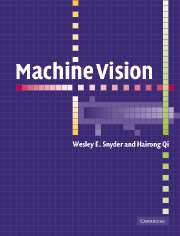Book contents
- Frontmatter
- Contents
- To the instructor
- Acknowledgements
- 1 Introduction
- 2 Review of mathematical principles
- 3 Writing programs to process images
- 4 Images: Formation and representation
- 5 Linear operators and kernels
- 6 Image relaxation: Restoration and feature extraction
- 7 Mathematical morphology
- 8 Segmentation
- 9 Shape
- 10 Consistent labeling
- 11 Parametric transforms
- 12 Graphs and graph-theoretic concepts
- 13 Image matching
- 14 Statistical pattern recognition
- 15 Clustering
- 16 Syntactic pattern recognition
- 17 Applications
- 18 Automatic target recognition
- Author index
- Index
12 - Graphs and graph-theoretic concepts
Published online by Cambridge University Press: 05 June 2012
- Frontmatter
- Contents
- To the instructor
- Acknowledgements
- 1 Introduction
- 2 Review of mathematical principles
- 3 Writing programs to process images
- 4 Images: Formation and representation
- 5 Linear operators and kernels
- 6 Image relaxation: Restoration and feature extraction
- 7 Mathematical morphology
- 8 Segmentation
- 9 Shape
- 10 Consistent labeling
- 11 Parametric transforms
- 12 Graphs and graph-theoretic concepts
- 13 Image matching
- 14 Statistical pattern recognition
- 15 Clustering
- 16 Syntactic pattern recognition
- 17 Applications
- 18 Automatic target recognition
- Author index
- Index
Summary
Functions are born of functions, and in turn, give birth or death to others. Forms emerge from forms and others arise or descend from these
L. SullivanYou have already seen the use of graph-theoretic terminology in connected component labeling in Chapter 8. The way we used the term “connected components” in the past was to consider each pixel as a vertex in a graph, and think of each vertex as having four, six, or eight edges to other vertices (that is, four-connected neighbors, six neighbors if hexagonal pixel is used, and eight-connected neighbors). However, we did not build elaborate set-theoretic or other data structures there. We will do so in this chapter. The graph-matching techniques discussed in this chapter will be used a great deal in Chapter 13.
Graphs
A graph is a relational data structure. It consists of data elements, referred to as vertices or nodes, and relationships between vertices, referred to as edges.
Graphs may be completely described by sets. The set of vertices is a simple set, and the edges form a set of ordered pairs. For example, let G = 〈V, E〉 represent a graph, where the vertex set V = {a, b, c, d, e, f} and the edge set E = {(a, b), (b, c), (a, c), (b, e), (d, f)}. Graphs may also be represented pictorially.
- Type
- Chapter
- Information
- Machine Vision , pp. 290 - 297Publisher: Cambridge University PressPrint publication year: 2004



